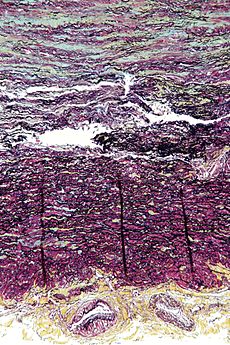- Familial thoracic aortic aneurysm
-
Familial thoracic aortic aneurysm Classification and external resources 
Micrograph showing cystic medial degeneration, the histologic correlate of familial thoracic aortic aneurysms. The image shows abundant basophilic ground substance in the tunica media (blue at top of image) and disruption of the elastic fibers. The tunica adventitia (yellow at bottom of image) with vaso vasorum is also seen. Movat's stain.ICD-9 441.00 OMIM 607086 DiseasesDB 30073 eMedicine emerg/28 Familial thoracic aortic aneurysm (also referred to as familial aortic dissection or cystic medial necrosis of aorta)[1] is an autosomal dominant[1] disorder of large arteries.
There is an association between familial thoracic aortic aneurysm and Marfan syndrome as well as other hereditary connective tissue disorders.
Contents
Presentation
A degenerative breakdown of collagen, elastin, and smooth muscle caused by aging contribute to weakening of the wall of the artery.[2]
In the aorta, this can result in the formation of a fusiform aneurysm. There is also increased risk of aortic dissection.
Genetics
Types include:
Type OMIM Gene Locus AAT1 607086 11q23.3-q24 AAT4 132900 MYH11 16p AAT6 611788 ACTA2 10q Terminology
It is sometimes called "Erdheim cystic medial necrosis of aorta", after Jakob Erdheim.[3][4]
The term "cystic medial degeneration" is sometimes used instead of "cystic medial necrosis", because necrosis is not always found.
References
- ^ a b Online 'Mendelian Inheritance in Man' (OMIM) 607086
- ^ Wiesenfarth, John, http://www.emedicine.com/emerg/topic28.htm, October 4, 2005
- ^ synd/2409 at Who Named It?
- ^ J. Erdheim. Medionecrosis aortae idiopathica (cystica). Archiv für pathologische Anatomie und Physiologie und für klinische Medizin, 1929, 273: 454-479.
See also
External links
- GeneReview/NCBI/NIH/UW entry on Thoracic Aortic Aneurysms and Aortic Dissections
- 1449852953 at GPnotebook
Categories:- Diseases of the aorta
- Genetic disorders by system
- Genetic disorder stubs
Wikimedia Foundation. 2010.
